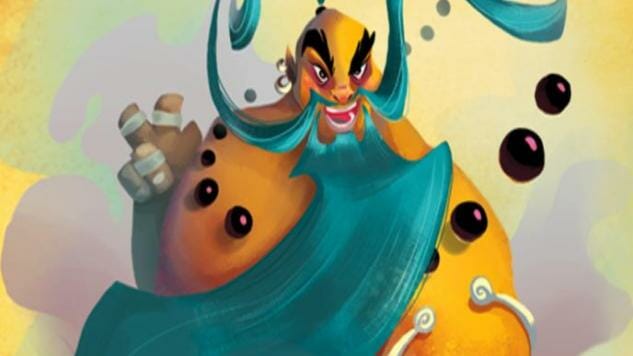
3 Wishes is a one-deck, five minute game in the vein of Love Letter, the surprise 2014 hit from designer Seiji Kanai that has spawned a slew of similar games as well as spinoffs tying the base game to Archer, The Hobbit, and Batman. Where Love Letter involved bluffing, however, 3 Wishes has a more direct line into sticking it to your opponents, and allows players to end the game when they choose, creating some urgency to stop your opponent from doing so if you think s/he has the cards to win.
3 Wishes’ total deck includes 19 cards for a full five-player game, removing three specific cards if you have four players and six specific cards if you have three. After shuffling the remaining deck, you remove one card, play two face-down on the table, and then deal three also face-down to each player, who may then look at just one of his/her cards before the game begins. On a turn, each player may take just two of the following actions: Peek at any card on the table, his own or someone else’s or the two in the center; switch any two cards on the table; or shuffle her own cards and peek at one before placing all three face-down again.
The game’s theme is that players have found a genie and one must come up with the best combination of three wishes to impress him and garner his favor. It’s a little pasted-on as themes go, but in a game where you barely look at your cards at all any sort of theme is going to feel superfluous. Sixteen of the game’s 19 cards are blue, pink, and yellow wish cards, each with a point value from 1 to 4. To win the game you must have one card of each color in the three in front of you; if more than one player’s hand meets that condition, the player with the most total points is the winner. Two cards in the deck lack point values but instead double the other cards in your hand; if you get both of those doubling cards plus a third card that’s blue, thus giving you one card of each color, you win automatically regardless of your score. The final card, Time Travel, makes the genie angry that you even asked, and if you end the game with it in your hand, you lose.
After every player has taken at least three turns, any player may choose to use his/her entire turn to declare the game over, after which all players reveal their cards and tally their scores. That means that you have until then to, at the very least, figure out what cards you have and try to get an idea of what your opponents have. With the optimal first move—at least, as far as I could tell—using your two actions to look at your other two cards, so at least you know what your starting three are, that means you’ve got two turns to either set yourself up to win or try to stick it to some of your opponents to stop them from doing so before you.
The games do indeed play out in three to five minutes, since there are few decisions to make and turns take so little time. Once Time Travel enters play, it’s going to keep going back and forth unless someone switches it to the center. The doubling cards become coveted and often drive someone to choose the shuffle action. Most other moves involve switching out cards to get the color(s) you need, or, if you’ve already got your three colors lined up, trying to improve your points. I thought from reading the rules that there’d be some benefit to switching opponents’ cards to screw them both up, but it was never the optimal decision given how little I knew about the cards they were holding.
That’s the main difference between this game and similar social tiny-deck games like Love Letter or Coup. The deck is actually a little too big for deduction to play a role; you can certainly calculate some odds as you peek at more cards, but between the cards that you don’t see or that are omitted from the game and frequent card movement, the gains from doing the math are quite small. That opens the game up more to younger players, though, and my ten-year-old grasped it right away and asked to play it again and again. I’d rate it a bit below the two similar games I mentioned above, but if you like either of those, 3 Wishes is a nice change of pace for under $10.
Keith Law is a senior baseball writer for ESPN.com and an analyst on ESPN’s Baseball Tonight. You can read his baseball content at search.espn.go.com/keith-law and his personal blog the dish, covering games, literature, and more, at meadowparty.com/blog.